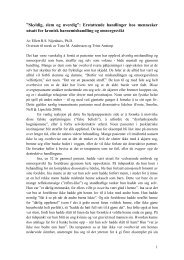rapport 2015:4
641aa6d88d
641aa6d88d
Create successful ePaper yourself
Turn your PDF publications into a flip-book with our unique Google optimized e-Paper software.
88. Köhnken, G., et al. (1995). The cognitive interview<br />
and the assessment of the credibility of adults’<br />
statements. Journal of Applied Psychology. 80(6):<br />
p. 671.<br />
89. Kuehnle, K. and M. Connell (2009). The evaluation<br />
of child sexual abuse allegations: A comprehensive<br />
guide to assessment and testimony, in The evaluation<br />
of child sexual abuse allegations: A comprehensive<br />
guide to assessment and testimony, John<br />
Wiley & Sons Inc; US: Hoboken, NJ. p. xxv, 571.<br />
90. Lamb, M.E. (2014). How I got started: Drawn into<br />
the life of crime: Learning from, by, and for child<br />
victims and witnesses. Applied Cognitive Psychology.<br />
28(4): p. 607-611.<br />
91. Brown, D.A., et al. (2013). The NICHD investigative<br />
interview protocol: an analogue study. Journal<br />
of Experimental Psychology: Applied. 19(4): p.<br />
367-82.<br />
92. Cyr, M. and M.E. Lamb (2009). Assessing the<br />
effectiveness of the NICHD investigative interview<br />
protocol when interviewing French-speaking<br />
alleged victims of child sexual abuse in Quebec.<br />
Child Abuse & Neglect. 33(5): p. 257-68.<br />
93. Benia, L.R., et al. (<strong>2015</strong>). The NICHD Investigative<br />
Interview Protocol: A meta-analytic review. Journal<br />
of Child Sexual Abuse. 24(3): p. 259-279.<br />
94. Hershkowitz, I., et al. (2013). Does enhanced<br />
<strong>rapport</strong>-building alter the dynamics of investigative<br />
interviews with suspected victims of intra-familial<br />
abuse? Journal of Police and Criminal Psychology.<br />
30(1): p. 6-14.<br />
95. Lyon, T.D. (2005). Speaking with Children: Advice<br />
from Investigative Interviewers, in Handbook for<br />
the treatment of abused and neglected children,<br />
Haworth Social Work Practice Press; US: Binghamton,<br />
NY. p. 65-81.<br />
96. Saywitz, K.J. and L. Snyder (1996). Narrative elaboration:<br />
Test of a new procedure for interviewing<br />
children. Journal of Consulting and Clinical<br />
Psychology. 64(6): p. 1347-1357.<br />
97. Saywitz, K.J. and L.B. Camparo (2014). Evidencebased<br />
child forensic interviewing: The developmental<br />
narrative elaboration interview: Interviewer<br />
guide. Programs that work. New York, NY: Oxford<br />
University Press; US.<br />
98. Bernet, W. (1997). Practice parameters for the<br />
forensic evaluation of children and adolescents<br />
who may have been physically or sexually abused.<br />
American Academy of Child and Adolescent Psychiatry.<br />
Journal of the American Academy of Child &<br />
Adolescent Psychiatry. 36(10 Suppl): p. 37S-56S.<br />
99. Walters, S., et al. (2003). Finding Words: Half<br />
a nation by 2010: Interviewing children and<br />
preparing for court. USA: National Center for<br />
Prosecution of Child Abuse, National Distric<br />
Attorneys Association.<br />
100. Gamst, T. and Å. Langballe (2004). Barn som<br />
vitner: En empirisk og teoretisk studie av kommunikasjonen<br />
mellom avhører og barn i dommeravhør:<br />
Utvikling av en avhørsmetodisk tilnærming.<br />
Doktoravhandling, Institutt for spesialpedagogikk.<br />
Universitetet i Oslo.<br />
101. Langballe, Å. (2011). Den dialogiske barnesamtalen-Hvordan<br />
snakke med barn om sensitive<br />
temaer. Nasjonalt kunnskapssenter om vold og<br />
traumatisk stress. Tilgjengelig fra: http://www.<br />
nkvts. no/biblioteket/Publikasjoner/Den-dialogiske-barnesamtalen-hvordansnakke.<br />
pdf Lastet<br />
ned. 8: p. 14.<br />
102. Lyon, T.D., M.E. Lamb, and J. Myers (2009).<br />
Authors’ response to Vieth (2008): Legal and<br />
psychological support for the NICHD interviewing<br />
protocol. Child Abuse & Neglect. 33(2): p. 71-74.<br />
103. Vieth, V. (2008). Re: The development of forensic<br />
interview training models: A reply to Lamb, Orbach,<br />
Hershkowitz, Esplin, and Horowitz (2007). Child<br />
Abuse & Neglect. 32(11): p. 1003-1006.<br />
104. Laraque, D., A. DeMattia, and C. Low (2006).<br />
Forensic child abuse evaluation: a review. The<br />
Mount Sinai Journal of Medicine, New York. 73(8):<br />
p. 1138-1147.<br />
105. Lyon, T.D. and K.J. Saywitz (2006). From postmortem<br />
to preventive medicine: Next steps for<br />
research on child witnesses. Journal of Social<br />
Issues. 62(4): p. 833-861.<br />
106. Powell, M.B. (2002). Specialist training in investigative<br />
and evidential interviewing: Is it having any<br />
effect on the behaviour of professionals in the field?<br />
Psychiatry, Psychology and Law. 9(1): p. 44-55.<br />
96<br />
Rapport <strong>2015</strong>:4 • Folkehelseinstituttet



